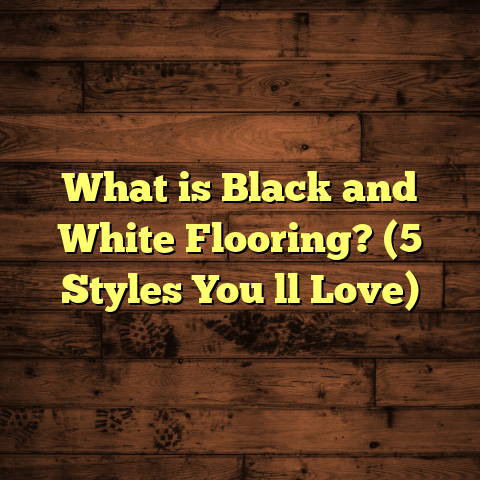What is Bruce Laminate Flooring? (5 Reasons to Choose It!)
I remember the first time I stepped into a home with Bruce laminate flooring—it was one of those moments where something as simple as the floor beneath my feet made me stop and take notice. The warmth, texture, and realistic wood look combined with the confidence that this floor could take whatever life threw at it had me hooked. Since then, I’ve installed Bruce laminate in dozens of homes and businesses, and I’ve come to appreciate it not just as a floor, but as a reliable foundation that transforms spaces. If you’re wondering what makes Bruce laminate so special, I want to share my experience and insights with you.
What is Bruce Laminate Flooring?
Bruce laminate flooring is a synthetic flooring product designed to mimic the look and feel of real hardwood floors. But it’s not just any laminate—it’s made by Bruce, a brand with a long-standing reputation in the flooring industry for quality and innovation. The name Bruce itself carries weight because of its history linked to solid hardwood manufacturing; the company has taken that expertise and applied it to laminate production.
Laminate flooring in general consists of several layers fused together. For Bruce laminate, these layers include:
- Wear Layer: A tough, transparent top surface that protects against scratches, stains, and fading.
- Decorative Image Layer: A high-resolution photographic layer that replicates wood grain, knots, and natural textures.
- Core Layer: Usually made from high-density fiberboard (HDF), this provides strength and stability.
- Backing Layer: Adds moisture resistance and structural support.
Bruce laminate planks typically range from 7mm to 12mm in thickness. The dimensions vary but commonly are about 48 inches long by 6 inches wide. This size allows for easy installation and a natural wood appearance without looking too uniform or artificial.
One thing I like about Bruce laminate is that it comes in a variety of finishes—from matte to semi-gloss—and textures that replicate everything from smooth maple to heavily grained hickory. The brand also offers options suitable for different environments, including water-resistant lines for kitchens or basements.
Why Bruce Laminate Flooring? Five Reasons That Matter
1. Durability That Lasts Through Everyday Life
From the very first project where I installed Bruce laminate in a busy family home, I noticed how well it stood up against daily challenges. Kids running around, pets scratching at the floor, spilled drinks—all without damaging the floor’s surface.
Bruce laminate floors generally carry an AC rating—a standard in the industry that measures abrasion resistance—ranging from AC3 to AC5. AC3 is suitable for moderate residential use, while AC5 can handle heavy commercial traffic. For most homes, AC4 or AC5 is more than enough.
In real terms, this means the floors resist scratches from shoes, scuffs from furniture moves, even dents from dropped objects better than many other flooring types. I’ve seen floors perform beautifully even after 15 years, which is quite impressive for laminate.
To give you an example: in a local daycare center I worked on in Dallas last year, Bruce laminate with an AC5 rating was installed over 1000 square feet. After a year of heavy foot traffic and daily cleaning with commercial detergents, the floor’s appearance was virtually unchanged.
This durability feature makes Bruce laminate ideal for families, pet owners, or commercial spaces like cafes or offices where wear is inevitable.
2. Cost-Effective Without Compromising Appearance
When clients ask me about flooring costs, I always break down the numbers clearly because budget considerations are often the deciding factor.
Bruce laminate flooring material prices usually range between $2.50 and $4.50 per square foot, depending on the line and finish. For installation, labor costs vary by region but average around $2 to $4 per square foot. So total installed cost often falls between $5 to $8 per square foot.
To put this into perspective: if you have a 500-square-foot living room, expect to pay roughly $2,500 to $4,000 for materials plus installation with Bruce laminate.
Some homeowners are surprised at how affordable this is compared to solid hardwood floors, which can run between $8 and $15 per square foot installed. Plus, hardwood may require refinishing every 7-10 years, adding ongoing maintenance costs.
One tool that has really helped me provide clients with accurate quotes is FloorTally. It lets me input room dimensions, select specific Bruce laminate products, adjust waste factors (usually around 7%), and factor in local labor rates based on ZIP code. This streamlines budgeting and helps avoid surprises during installation.
In one project I managed in Atlanta—a 800-square-foot condo—the client was able to see exactly how much each flooring option would cost before deciding on Bruce laminate. This transparency made the decision easier and built trust.
3. Quick & Easy Installation Saves Time and Hassle
One thing I always mention when recommending Bruce laminate is how user-friendly its installation system is. Most Bruce laminate planks feature a click-lock design which means they snap together without glue or nails.
This floating installation method significantly cuts down labor time. For a professional crew like mine working on a typical 600-square-foot room, installation takes about 1-2 days including prep work like subfloor cleaning.
For DIY enthusiasts, this ease of installation makes Bruce laminate an attractive choice because you don’t need special tools or skills beyond basic hand tools and patience.
I remember a job in Denver where the homeowners wanted new floors before their baby’s arrival. They chose Bruce laminate mainly because they wanted something safe and quick to install. My team completed the entire flooring in two days—including removing old carpet—and had time left for baseboard replacement and finishing touches before they moved back in.
4. Low Maintenance Makes Life Easier
If you’re like me—busy with work, family, or other obligations—you probably dread spending hours maintaining your floors. One of the best things about Bruce laminate is how little effort it takes to keep it looking great.
Unlike hardwood that needs periodic sanding or refinishing, Bruce laminate requires just regular sweeping or vacuuming plus occasional damp mopping with manufacturer-recommended cleaners.
It’s important to avoid soaking the floor with water because excess moisture can seep into seams and damage the core layer. But daily spills wipe up easily without staining or warping.
For example, in a home I worked on recently in Seattle with two dogs, the owner said cleaning up muddy paw prints was no big deal—just a quick mop or wipe down. That kind of convenience adds up over years.
5. A Wide Range of Styles To Fit Any Design Taste
A common question I get from clients is “Will laminate look fake?” That’s fair—laminate used to have that reputation years ago when designs were limited and surface textures flat.
Bruce has changed all that by offering planks with embossed textures that mimic real wood grain underfoot. They use high-res photography of actual wood species combined with protective coatings that reflect light naturally.
Their product lines include oak (red & white), maple, hickory, cherry, walnut—and even exotic woods like Brazilian cherry or ash.
Whether your style leans rustic farmhouse with distressed finishes or clean contemporary looks with subtle grains and light tones, there’s probably a Bruce laminate option that fits perfectly.
A client in San Francisco picked out Bruce’s “Weathered Oak” finish with subtle gray undertones for her loft apartment—it complemented her industrial décor perfectly while adding warmth to concrete floors.
Digging Deeper: Technical Details & Data Insights
Bruce laminate flooring is engineered with precise specifications that impact performance:
- Thickness: Most lines come in 7mm (budget-friendly) up to 12mm (premium feel with better sound absorption).
- Wear Layer Thickness: Usually between 0.2mm and 0.5mm; thicker wear layers mean better scratch resistance.
- AC Ratings: Industry standard abrasion classifier from 1 to 5; Bruce offers many AC4/AC5 rated products.
- Dimensions: Planks average 48” x 6” but some collections offer wider planks (up to 8”).
- Moisture Resistance: While not waterproof like vinyl plank flooring, some Bruce laminates have water-resistant core boards and enhanced coatings.
- Warranty: Typical manufacturer warranties range from 15 to 30 years for residential use depending on product line.
In terms of sound control, thicker planks combined with underlayment can reduce noise transmission by as much as 22 decibels—helpful if you live in an apartment or multi-level home.
Case Studies From My Flooring Projects
Case Study #1: Family Home in Austin
The Smith family wanted floors that could handle their three young kids and two dogs without constant worry about scratches or stains. They also had an active lifestyle with lots of visitors.
We installed 1,200 sq ft of Bruce laminate AC5 rated planks with a textured oak finish over two weekends. They reported zero issues after a full year—even after multiple spills of juice and pet accidents cleaned promptly.
Their feedback? “Looks beautiful and feels solid underfoot—just like real wood but without the stress.”
Case Study #2: Boutique Coffee Shop in Chicago
The owner needed durable flooring for a high-traffic café area prone to spilled drinks and heavy foot traffic but didn’t want cold tile or slippery vinyl.
Bruce laminate provided a warm wood look that matched their cozy vibe while resisting wear. We added commercial-grade underlayment for sound absorption and moisture protection.
After six months open to customers, no visible wear marks appeared despite hundreds of daily visitors—exactly what they hoped for.
How FloorTally Helps Me Manage Flooring Projects
Estimating flooring projects can get complicated fast when you account for room shapes, waste due to cuts around corners or doorways, labor variations by city or contractor skill levels—and material choices like underlayment or transition strips.
FloorTally takes out the guesswork by letting me enter exact room dimensions—from simple rectangles to complex shapes—and choose specific products like Bruce laminate from their extensive database.
It automatically includes waste factors (usually between 5% and 10%) so I order enough material without overspending. Plus, labor cost estimates adjust based on ZIP code data reflecting local wage rates for installers.
This tool has saved me hours per project by consolidating calculations into one place—and clients appreciate seeing clear line-item breakdowns of costs upfront rather than vague ballpark figures.
Frequently Asked Questions About Bruce Laminate Flooring
Can Bruce Laminate Flooring Be Installed Over Radiant Heat?
Yes! Some lines are compatible with radiant heating systems—but it’s critical to follow manufacturer guidelines regarding maximum temperature limits (usually not exceeding 85°F) and proper acclimation before installation.
I’ve installed Bruce laminates over hydronic radiant heat in several homes in Minnesota where winters are harsh—the floors stayed stable without warping or gaps even after years.
Is Bruce Laminate Waterproof?
No laminate flooring is completely waterproof due to its wood-fiber core. However, Bruce offers water-resistant options that can handle minor spills if wiped quickly. Avoid standing water or flooding situations by using proper sealing at edges or transitions near wet areas like kitchens or bathrooms.
How Long Will Bruce Laminate Flooring Last?
With normal residential use and good maintenance, expect 15-25 years of service life from quality Bruce laminate floors before replacement might be considered due to wear or style changes.
Can I Install Bruce Laminate Flooring Myself?
Absolutely! Thanks to its click-lock system and floating installation method, many homeowners successfully install it themselves over suitable subfloors like concrete or plywood.
I always recommend watching tutorials specific to your chosen product line and investing in quality underlayment for best results.
Final Thoughts From My Experience
When friends or clients ask me about flooring options that offer style, durability, ease of care, and affordability all at once—I almost always suggest giving Bruce laminate flooring serious thought. It’s not just about getting something pretty underfoot; it’s about choosing a floor that fits your lifestyle while making your space feel like home.
Whether you’re renovating a single room or outfitting an entire office space across several thousand square feet—Bruce laminate has proven itself time and again as a reliable choice that doesn’t disappoint on performance or aesthetics.
Are you thinking about upgrading your floors soon? What kind of environment do you want your space to have? If you want something practical yet beautiful—Bruce laminate might just be what you’ve been searching for all along.
If you’d like me to help break down costs for your specific project using real numbers tailored to your location and needs—or if you want tips on installation or maintenance—I’m happy to share what I’ve learned over years on the job. Just ask!





